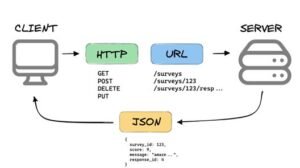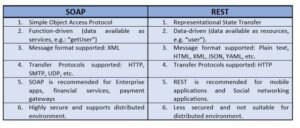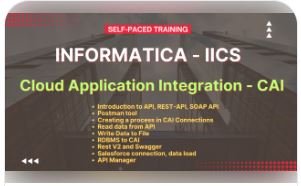Informatica IDMC/IICS interview questions and answers
1. What is Cloud Application Integration?
Informatica Cloud Application Integration provides end-to-end solutions designed for Web Applications. This online API Design system offers Android & mobile support, Dashboards and analytics, Activity Dashboard, API Design, API Integration, API management, API Monitoring, API Testing, Communication Logs, Database services, Documentation Management, Help And Support, Help Desk, Import/Export Database at one place.
Informatica Cloud Application Integration (CAI) service offers a single, trusted solution to support any integration pattern, data set, user type, or endpoint to automate business processes, expedite transactions, and enable real-time analytics.
- Reimagine your API, process, and application integration in a multi-cloud world. Accelerate your business, drive innovation, and create efficiencies by intelligently connecting any app, any data, anywhere, at any speed. Enhance agility by publishing events across applications in real-time using APIs.
- Automate user processes and business functions across your application landscape. Deliver data, process, and event services as APIs to be consumed by applications and partners.
- Informatica’s event-driven and service-oriented application integration capabilities encompass event processing, service orchestration, and process management.
- These are built on Informatica’s business process management technology. Its use within Integration Cloud, embedded within the Cloud Secure Agent, makes it possible to create and consume APIs, orchestrate data services and business services, integrate processes, and offer data and applications services inside and outside an organization.
2. What are the benefits of using Informatica CAI?
As we know enterprises are rapidly expanding the application and data to multiple cloud deployments. If we take an example of normal comparison flow, it will traverse through multiple workflows and applications which can be on-premises or on-cloud, for successful completion of it, there should be tight integrity between on-premises, on-cloud applications, and databases.
Many enterprises face many issues with the integration technologies i.e., expensive, hard-to-maintain latency issues, etc. These issues can be mitigated by using a single integration platform like Informatica.
3. Can you explain some Key Features of CAI?
- Single design tool – Use a single tool for API creation, real-time analytics, and process automation.
- Data at any latency – for bridging API and event systems, publish data to and propagate data at latency and in formats that subscribers prefer.
- Secure Agent – It is a lightweight program that enables communication b/w IICS and across the enterprise firewall.
- Connectivity – We can choose either 150 connectors or join 6000 custom connectors to leverage different data sets, applications, and services.
4. Can you name different API integration tools?
Here are several of the most popular API integration tools that you should consider using for your business operations.
- Dell Boomi
Dell Boomi is a cloud-based API solution and integration platform as a service (iPaaS) tool. Boomi features low-code development, meaning users can connect services and applications with little to no coding.
- Apigee API Management
Apigee allows users to build API proxies. An API proxy is a bundle of XML configuration files and code that decouples the front-end and back-end of an API structure. Essentially, it is an API server that sits between an application and the back-end.
- IBM API Connect
IBM API Connect is a user-friendly enterprise solution for API creation and management. Analytics and built-in security are some of its most appealing features.
- MuleSoft
Like other API integration tools, the MuleSoft Any Point Platform enables developers to design, build, and manage APIs speedily, using clicks or code.
- Akana
Akana provides end-to-end API management. In simple terms, this means you can access and manage the full API lifecycle within the Akana platform.
- Microsoft Azure API Management
You can manage all your APIs in one place with Microsoft Azure API Management. Get insights through API analytics and keep your APIs secure with token, key, and IP filtering functionalities.
- Zapier
Zapier extends thousands of app integrations from an easy-to-use, visual interface. The primary motive of the platform is to entrust non-tech-savvy users with the tools to automate workflows.
5. In what way does Cloud Application integration enable businesses?
- Informatica’s cloud application integration capabilities are ideal when you need service-oriented integration.
- Transactions that run for a long time and keep their status. Integration sequences, alternative execution pathways, or composite transactions are required for short-running or transactional system integration operations.
- Parallel execution semantics that is rich
- Event triggers and timers
- The decadent event, fault, and error-handling systems that govern how and what to compensate for through automatic compensation to roll back a transaction if all needed stages are not completed.
6. How does CAI benefit the organization?
Among all new data versions in software, Informatica cloud application integration is one of the best integration techniques. By establishing us as experts in a technological field. Connect any app, any information, anywhere to help your business develop, build efficiency in the business process, and significantly increase transactions while allowing real-time analytics.
Event processing, service orchestration, and process management are part of Informatica’s event-driven and service-oriented application integration capabilities. Its use within Integration Cloud, incorporated within the Cloud Secure Agent, enables the creation and consumption of APIs, the orchestration of data and business services, the integration of processes, and the provisioning of data and application services both inside and outside an organization.
7. What do you like best about Informatica API and Application Integration?
Offerings such as Cloud Data Integration provide a complete ETL solution. However, the Cloud Application Integration adds value as an orchestration platform. This removes the overhead of using any coding platform such as Unix, python, and GUI-based interface and provides a unique drag-drop kind of experience. The Mass Ingestion service is an add-on.
Data Integration and API integration, Faster development and avoiding hand coding, easy to use, and excellent support. Integrates with most of the database and cloud connectors including, AWS, Azure, GCP, and Snowflake.
8. What do you dislike about Informatica API and Application Integration?
Many use cases are not handled for which we had to raise multiple cases with Informatica. The main aspect is the Feature Request created sometimes takes longer than usual which could be improved, by at least providing an ETA.
9. What problems are Informatica API and Application Integration solving and how is that benefiting you?
We are serving as a Data Integration project serving many sources of various database types, Flat File, API, etc., and various downstream applications. IICS helps us in bridging the gap and serving our downstream applications.
10. What is an API?
An Application Programming Interface is a way for two or more computer programs to communicate with each other. It is a type of software interface, that offers a service to other pieces of software. A document or standard that describes how to build or use such a connection or interface is called an API specification.
 11. How an API works?
11. How an API works?
A simple way to understand how APIs work is to look at a common example—third-party payment processing. When a user purchases a product on an e-commerce site, they may be prompted to “Pay with PayPal” or another type of third-party system. This function relies on APIs to make the connection.
- When the buyer clicks the payment button, an API calls to retrieve information—also known as a request. This request is processed from an application to the web server via the API’s Uniform Resource Identifier (URI) and includes a request verb, headers, and sometimes, a request body.
- After receiving a valid request from the product webpage, the API makes a call to the external program or web server, in this case, the third-party payment system.
- The server sends a response to the API with the requested information.
- The API transfers the data to the initial requesting application, here is the product website.
While the data transfer will differ depending on the web service being used, the requests and responses all happen through an API. There is no visibility on the user interface, meaning APIs exchange data within the computer or application, and appear to the user as a seamless connection.
12. What is the difference between APIs and Web services
- A web service is a software component that can be accessed and facilitates data transfers via a web address. Because a web service exposes an application’s data and functionality to other applications, in effect, every web service is an API. However, not every API is a web service.
- APIs are any software component that serves as an intermediary between two disconnected applications. While web services also connect applications, they require a network to do so. Where some APIs are open source, web services are typically private, and only approved partners may access them.
13. What are the different API protocols available?
As the use of web APIs has increased, certain protocols have been developed to provide users with a set of defined rules, or API specifications, that create accepted data types, commands, and syntax. In effect, these API protocols facilitate standardized information exchange.
- SOAP (Simple Object Access Protocol): Built with XML, SOAP enables endpoints to send and receive data through SMTP and HTTP. SOAP APIs make it easier to share information between apps or software components that are running in different environments or written in different languages.
- XML-RPC (XML-Remote Procedure Call): The XML-RPC protocol relies on a specific XML format to transfer data. XML-RPC is older than SOAP, but much simpler, and relatively lightweight in that it uses minimum bandwidth.
- JSON-RPC: Like XML-RPC, JSON-RPC is a remote procedure call, but JSON (JavaScript Object Notation) is used instead of XML to transfer the data.
- REST (Representational State Transfer): REST is a set of web API architecture principles. REST APIs—also known as RESTful API)—are APIs that adhere to certain REST architectural constraints. It’s possible to build RESTful APIs with SOAP protocols, but the two standards are usually viewed as competing specifications.
Traditionally, API referred to an interface connected to an application created with any of the low-level programming languages, such as JavaScript. Modern APIs, however, adhere to REST principles and the JSON format. They are typically built for HTTP, resulting in developer-friendly interfaces that are easily accessible and widely understood by applications written in Java, Ruby, Python, and many other languages.
14. What is SOAP-API?
Simple Object Access Protocol (SOAP) is a message specification for exchanging information between systems and applications. When it comes to application programming interfaces (APIs), a SOAP API is developed in a more structured and formalized way.
Think of SOAP as being like the national postal service: It provides a reliable and trusted way to send and receive messages between systems (and within enterprise applications). It is older, established, and dependable—but it can be slower than competing architectural styles like REST.
SOAP utilizes XML as part of a standard communication protocol that allows for the exchange of structured information in distributed environments. SOAP lets applications that are running on different operating systems and in different programming languages communicate with each other.
15. What is REST-API?
Representational State Transfer (REST) is a software architecture that imposes conditions on how an API should work. RESTful API is an interface that two computer systems use to exchange information securely over the internet. Most business applications must communicate with other internal and third-party applications to perform various tasks.
For example, to generate monthly pay slips, your internal accounts system must share data with your customer’s banking system to automate invoicing and communicate with an internal timesheet application. RESTful APIs support this information exchange because they follow secure, reliable, and efficient software communication standards.

These are the general steps for any REST API call:
- The client sends a request to the server. The client follows the API documentation to format the request in a way that the server understands.
- The server authenticates the client and confirms that the client has the right to make that request.
- The server receives the request and processes it internally.
- The server returns a response to the client. The response contains information that tells the client whether the request was successful. The response also includes any information that the client requested.
16. What is the difference between REST and SOAP API?

17. Can you name some tools used for API Testing?
The following list includes some of the tools used for API testing:
- Postman
- Tricentis Tosca
- Katalon Studio
- Apigee
- Jmeter
- SoapUI
18. What is Postman for API testing?
Postman is a popular tool for API testing that allows developers to create and execute HTTP requests and test API responses. Postman makes API testing more efficient and effective with features such as request builders, response visualizations, and test automation.
Postman is an application used for API testing. It is an HTTP client that tests HTTP requests, utilizing a graphical user interface, through which we obtain different types of responses that need to be subsequently validated.
- Postman is an application that allows us to test APIs utilizing a graphical user interface.
- Some of Postman’s advantages include the collection feature and the possibility to create different testing environments.
- Postman is a user-friendly tool that helps us optimize our time when executing tests.
19. What is an HTTP request?
An HTTP request is a program that the client makes to a name host located on a server. It works as a communication interface or a request-response protocol between a client and server. The primary use of the HTTP request is to access a resource on the server. To initiate the HTTP request, the client uses components of a URL (Uniform Resource Locator) that also includes the information needed to access the resource.
20. Name different endpoint methods supported by Postman.
Postman offers many endpoint interaction methods. The following are some of the most used, including their functions:
- GET: Obtain information
- POST: Add information
- PUT: Replace information
- PATCH: Update certain information
- DELETE: Delete information
Enroll for Informatica IICS Cloud Data Integration(CAI) – Self-Paced courses
![]()



